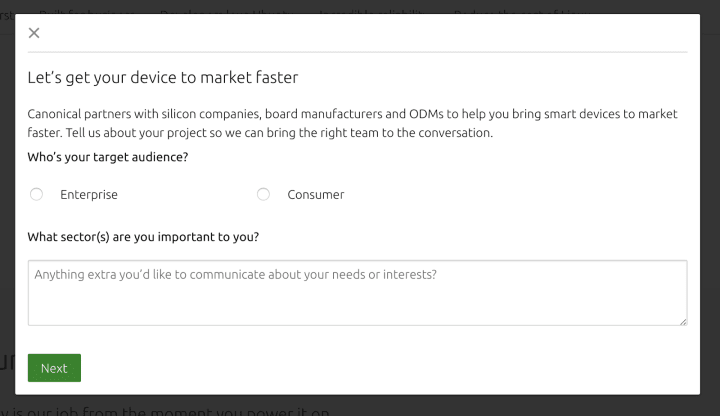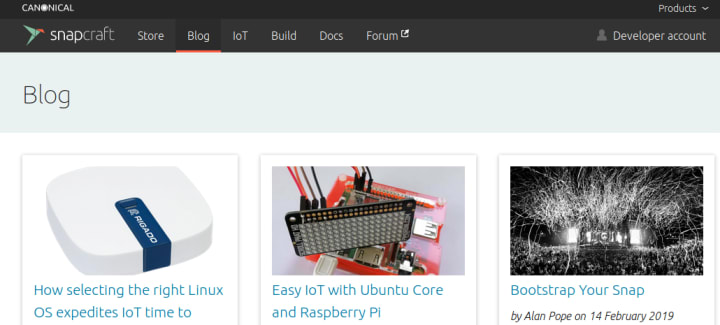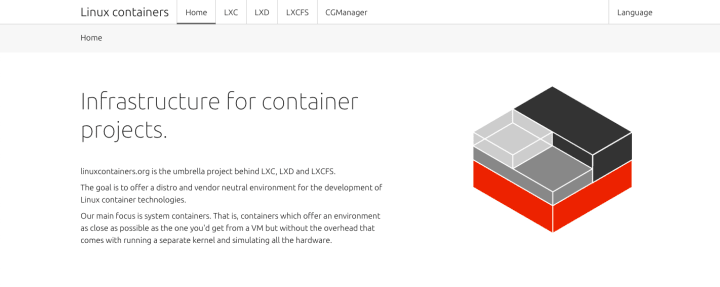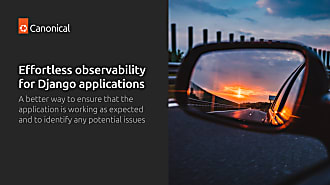Anthony Dillon
on 20 February 2019
Snapcraft squad
Report a Snap
Last year, a snap was found in the Snap Store using computing resources for bitcoin mining without user consent. This software was retired from the Store after further investigation and highlighted the need for snapcraft.io users to report potential snaps violating trademark, copyright or terms and conditions of the store.
Every snap now includes a link for reporting a violation on trademark, copyright or terms of service of the Snap Store. This will be handled by our Advocacy team for further investigation.
Public publisher pages – KDE
To allow snapcraft.io visitors being able to view all snaps from a specific publisher, we started creating content from relevant publishers. We are starting with KDE which we are working with Advocacy on getting all the necessary content.
Web squad
Rebuild of the Japanese Ubuntu website
After years of having a single page outlining all of our offerings, we decided it was time to grow the Japanese language website to better cover our range of cloud and IoT products. The site has grown to around 10 pages and will soon have a blog as well.
Please check it out – https://jp.ubuntu.com
Two new takeovers
Financial Services whitepaper

Ubuntu Core Full Disk Encryption

Wireframes for the new Canonical careers section
Careers section is starting to become outdated and could do with some more content that conveys Canonical’s culture and our office environment. We started with brainstorming and ideation sessions identifying problems, looking for solutions, gathering our ideas and looking at what we think are good examples/practices. After these sessions, we started producing wireframes and sharing them with stakeholders and peers to get their feedback. This is an iterative project that will continue for some more time.

Completed the interactive contact us forms
We completed the roll out of the section specific interactive contact us forms throughout https://www.ubuntu.com. If you add `#get-in-touch` to any URL on the website it will open an interactive contact us form. The new form you to provide more information about your request without leaving the page you are viewing.

Base squad
Here’s what the Base squad has been up to in the past two weeks (by Robin Winslow).
Moving Juju documentation to Discourse
As the next step in migrating the Juju documentation from its current repository into a Discourse-backed system, we’ve now populated the docs-import category in discourse.jujucharms.com.

We will now spend a few weeks checking and fixing the imported documentation pages, before switching the site over to display the content from Discourse instead – under the same model as docs.snapcraft.io.
A blog module for our websites
In addition to our main blog at blog.ubuntu.com, we also display blog posts on snapcraft.io/blog, whitepapers and case studies on www.ubuntu.com/resources, and we’re also planning on adding blog posts to jp.ubuntu.com. Each of these locations pull in content from the same WordPress API.

As well as jp.ubuntu.com, we’re likely to add /blog endpoints to more sites in future, so we’ve packages the code from snapcraft.io/blog into a Flask extension called canonicalwebteam.blog.
Convert jp.ubuntu.com to flask application
We recently formalised our suggestions for server-side frameworks for different project types. Under this model, we should be using Django only for sites that require an SQL database back-end, Flask for dynamic applications with no database, and Jekyll for static sites.

jp.ubuntu.com was running Django. However, converting it to Flask helps us apply the blog module we just wrote, and achieves greater consistency across all our sites. We will be integrating the blog module into jp.ubuntu.com next iteration.
Request caching back-end API
Many of our website application pull in data on the server-side from API calls to other services – e.g. snapcraft.io pulls its data from the api.snapcraft.io and dashboard.snapcraft.io APIs, and blog.ubuntu.com pulls in its data from a wordpress API .
These API calls are currently locally cached by the application, but this has caused us some problems, so we’ve been exploring ways to create a centralised cache back-end for all our website applications. We’re currently thinking of using Redis for this, but we’ll update here how this exploration progresses.
MAAS squad
Machine grouping UX & Visuals
We explored a large number of possible solutions for the group headings within the MAAS machines’ view and have a few equally strong proposals that will need to be reviewed. All of them are designed and ready to be build as soon as a decision is made.
Small form improvements
Forms are a huge part of MAAS – users need to interact with them in both editable and non-editable form most of the time while using the product and, unfortunately, currently there are inconsistencies between the way they are implemented as well as ways in which they can be improved. Following a workshop we came up with a two-sided approach to improving the forms: part one – quick fixes, and part two – more strategic, bigger ways to improve the experience. Part one are all things that will be completed this cycle, such as tidying up of checkboxes in the commissioning machine(s) menu and retracting the visual strength of labels for fields that cannot be edited. Part two is a much bigger piece of work that will require us to also look at how we use modality within MAAS. We have some initial ideas of ways to improve forms everywhere, however these will require much more further exploration.
Enable/modify/disable DHCP
In this iteration we completed the UX and design, and started building the new screens allowing the user to enable, modify, or disable DHCP in MAAS. The aim of this piece of work was to build upon existing designs and create a clear journey, allowing the user to focus on the information that is important when manipulating the DHCP configuration.



JAAS squad
Juju on K8s charms in GUI and other pages
The design team worked on implementing the JAAS UI with the K8s charm functionality currently present in Juju. JAAS will soon support the deployment of K8s charms on Kubernetes clusters, aligning with Juju and its command line experience.
These are a few screens that show how the K8s charms environment will differentiate from the classic machine/virtual-machine models.



Vanilla squad
Blog post on the refresh of releases.ubuntu.com
As part of the ongoing project to upgrade all of our websites to use our Vanilla Framework, we tackled releases.ubuntu.com, a website that lists all Ubuntu releases available for download.
Find out how we tackled it from design and development here.
Fixed some tooltip component issues
We updated our tooltip component to accommodate recent bugs raised by users here and here. We fixed the issue of tooltip hover being cut off in Firefox and tooltip placement on icons. These have all been fixed now and will release with v2.0

Updated the colours and icons documentation pages
Two new page layouts are live on Vanilla Documentation for Color and Icons, this is the beginning of docs content updates which will continue and release pages in the coming weeks.
Updated linuscontainers.org to the latest Vanilla
As part of the ongoing project to upgrade all of our websites to use our Vanilla Framework, we tackled linuxcontainers.org, a website that provides tools that help the infrastructure for container projects.

Brand squad
Produced a few whitepapers
Two new white papers ‘The magic of snap deltas’ and ‘Cloud Instance Initialisation with cloud-init’.
Updated the TV reception graphics
Created a template for the main TV reception graphics that is easily edited enabling the animations to be rendered out in minutes and uploaded with ease.
Exhibition for embedded world
The exhibition graphics for the Embedded World conference were designed and are now in production for the show in Germany at the end of the month.
Built the new corporate slide desk
The new corporate slide deck has now been built out into a useable template within Google Slides.
Work has begun on the new release mascot design
The new mascot for 19.04 Disco Dingo was designed with a number of variations produced, a final design was selected and t-shirts with the design are currently in production for the next engineering sprint in Malta at the end of the month.



